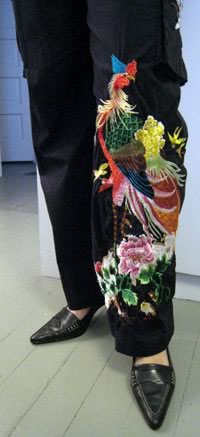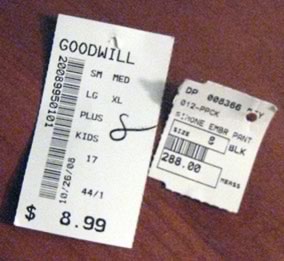Embracing the thrift-store ethic: 18 top tips for buying used clothes
If the national media is any indication, more people are embracing the notion of buying used clothing from thrift stores and consignment shops. Last week, USA Today ran a story describing how secondhand stores are reaping the benefits of recession:
As Americans look for ways to cut spending, they are scooping up bargain clothes, accessories, toys and furniture once owned by someone else.
“We’re sorry about the economic situation, … but it is a good time for our industry,” says Adele Meyer, executive director of the National Association of Resale & Thrift Shops. Three-fourths of resale stores said they had higher sales in September and October, compared with the same period last year, according to the trade group. The average sales increase was about 35%.
According to the article, 70% of adults surveyed last summer say that buying used is now more socially acceptable than it was a decade ago. Buying used has always been socially acceptable to me. I got in the habit of shopping at thrift stores during high school. It was the only way I could afford to add to my wardrobe. For the past 20 years, buying used has been a natural part of my shopping routine.
Kris and I are fortunate that Portlanders generally embrace the thrift-store ethic, and that we live near a highway lined with used clothing shops. (It’s actually more convenient for us to buy our clothes from thrift stores than any other source!) Here are some of our best tips for buying second-hand clothes:
- Set a budget. This is difficult at first — you don’t know how much things cost. But eventually you’ll be able to tell yourself, “I’m going spend $20 today”. It becomes a game to see how much you can buy for $20.
- Discard your prejudices. Some people consider thrift stores and used clothing shops nasty dirty places. Some are. Most aren’t. Explore your neighborhood. Find a shop or two that you like, and you’ll be hooked.
- Go with a friend. It’s good to have a second opinion. Your friend may have an eye for what looks good on you — and vice versa.
- Try things on. Sizes vary widely between manufacturers and even by eras. (Today’s clothes have looser fits.) But go in knowing your general size and measurements. Note that some places don’t have dressing rooms, so it’s smart to wear a modest thin layer in case you need to strip down in the aisle.
- Examine each item thoroughly. It sucks to get home to find your new shirt has a hole in the pocket. Or that the slacks you thought were a steal actually have a broken zipper.
- Check washing instructions. You don’t want to pay $3 for a silk blouse if you’ll never dry-clean it.
- Use the tags as a guide to find quality brands you like, but don’t limit yourself. Sometimes a brand you’ve never heard of can yield a favorite piece of clothing.
- Think layers. Maybe that shirt with a stain on the sleeve has a great collar for wearing under a sweater. For $3, you can afford to buy a single-purpose shirt.
- Use thrift stores as a way to diversify your wardrobe. Buy colors and styles on which you normally wouldn’t spend much. Wear the new clothes a few times to see how you like them, and to gauge the reaction of others.
- Used clothing stores are great for certain accessories. Why pay $30 for a new belt in a department store when you can get a better belt in your size for just $2? I like to shop at second-hand stores for hats. (Nice hats.)
- Look for clothes new with tags. Sometimes unsold department store inventory finds its way to used clothing stores and thrift shops. You’ll generally pay more for these items, but not much.
- If you won’t wear it, don’t buy it. You don’t save money buying a $3 shirt if it just sits in your closet for two years.
- Wash clothes when you get them home.
- Watch for sales. Used clothing stores (and thrift stores) run periodic specials. Our favorite local store just ran a half-off sale. The local thrift stores often have specials on certain items.
- If you go to the same store often, ask when they rotate stock. Stores get new shipments regularly. Most also have extra stock in storage. If you become familiar with the owners, you might even ask them to keep an eye out for particular items.
- Take your time. At normal clothing shops, everything is neatly organized. Not so at most thrift stores. When thrifting, it’s more important to be patient, to browse the racks methodically.
- If buying used clothes becomes a habit, institute a “one in-one out policy”. Every time you bring home something new, get rid of something old. (Give it away, take it to a thrift store, or save it for a garage sale.)
- Have fun! Buying used clothing can save you money. It’s also a fun way to kill a Saturday afternoon. At $3 an item, you can afford to be adventurous sometimes.
Another great thing about buying used is that you’re free to experiment a little bit more. It doesn’t hurt much to purchase a $5 cardigan sweater and then discover you’re not the sort for cardigans. On a recent shopping trip, for example, Kris picked up this garish pair of pants:

Kris thinks the pants are pretty hilarious. I do, too, but not in the same way. But what’s really surprising is the price tags. Check this out: these pants were originally priced at $288, but she picked them up for $8.99.

For many people, thrift stores offer an easy way to delve into frugal fashion. But most shops carry more than just clothes. If your budget is pinched, they’re an excellent place to find furniture, to pick up kitchenware, and even to find inexpensive entertainment. A large part of my personal finance library has been purchased from the local Goodwill (for about $3 per book).
Become A Money Boss And Join 15,000 Others
Subscribe to the GRS Insider (FREE) and we’ll give you a copy of the Money Boss Manifesto (also FREE)
